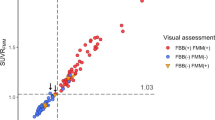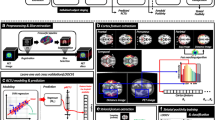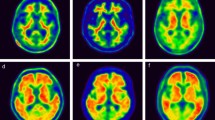Abstract
Purpose
In this study, we used machine learning to develop a new method derived from a ligand-independent amyloid (Aβ) positron emission tomography (PET) classifier to harmonise different Aβ ligands.
Methods
We obtained 107 paired 18F-florbetaben (FBB) and 18F-flutemetamol (FMM) PET images at the Samsung Medical Centre. To apply the method to FMM ligand, we transferred the previously developed FBB PET classifier to test similar features from the FMM PET images for application to FMM, which in turn developed a ligand-independent Aβ PET classifier. We explored the concordance rates of our classifier in detecting cortical and striatal Aβ positivity. We investigated the correlation of machine learning-based cortical tracer uptake (ML-CTU) values quantified by the classifier between FBB and FMM.
Results
This classifier achieved high classification accuracy (area under the curve = 0.958) even with different Aβ PET ligands. In addition, the concordance rate of FBB and FMM using the classifier (87.5%) was good to excellent, which seemed to be higher than that in visual assessment (82.7%) and lower than that in standardised uptake value ratio cut-off categorisation (93.3%). FBB and FMM ML-CTU values were highly correlated with each other (R = 0.903).
Conclusion
Our findings suggested that our novel classifier may harmonise FBB and FMM ligands in the clinical setting which in turn facilitate the biomarker-guided diagnosis and trials of anti-Aβ treatment in the research field.




Similar content being viewed by others
Data and materials availability
Anonymized data for our analyses presented in this report are available upon request from the corresponding authors.
Code availability
Not applicable.
References
Jack CR Jr, Bennett DA, Blennow K, Carrillo MC, Dunn B, Haeberlein SB, et al. NIA-AA Research Framework: toward a biological definition of Alzheimer’s disease. Alzheimer’s Dementia. 2018;14(4):535–62. https://doi.org/10.1016/j.jalz.2018.02.018.
Ikonomovic MD, Buckley CJ, Heurling K, Sherwin P, Jones PA, Zanette M, et al. Post-mortem histopathology underlying beta-amyloid PET imaging following flutemetamol F 18 injection. Acta Neuropathol Commun. 2016;4(1):130. https://doi.org/10.1186/s40478-016-0399-z.
Kim JP, Kim J, Kim Y, Moon SH, Park YH, Yoo S, et al. Staging and quantification of florbetaben PET images using machine learning: impact of predicted regional cortical tracer uptake and amyloid stage on clinical outcomes. Eur J Nucl Med Mol Imaging. 2019. https://doi.org/10.1007/s00259-019-04663-3.
Klunk WE, Engler H, Nordberg A, Wang Y, Blomqvist G, Holt DP, et al. Imaging brain amyloid in Alzheimer’s disease with Pittsburgh Compound-B. Ann Neurol. 2004;55(3):306–19. https://doi.org/10.1002/ana.20009.
Rinne JO, Wong DF, Wolk DA, Leinonen V, Arnold SE, Buckley C, et al. [(18)F]Flutemetamol PET imaging and cortical biopsy histopathology for fibrillar amyloid beta detection in living subjects with normal pressure hydrocephalus: pooled analysis of four studies. Acta Neuropathol. 2012;124(6):833–45. https://doi.org/10.1007/s00401-012-1051-z.
Wong DF, Rosenberg PB, Zhou Y, Kumar A, Raymont V, Ravert HT, et al. In vivo imaging of amyloid deposition in Alzheimer disease using the radioligand 18F-AV-45 (florbetapir [corrected] F 18). J Nucl Med Off Publ Soc Nucl Med. 2010;51(6):913–20. https://doi.org/10.2967/jnumed.109.069088.
Barthel H, Gertz HJ, Dresel S, Peters O, Bartenstein P, Buerger K, et al. Cerebral amyloid-beta PET with florbetaben (18F) in patients with Alzheimer’s disease and healthy controls: a multicentre phase 2 diagnostic study. Lancet Neurol. 2011;10(5):424–35. https://doi.org/10.1016/s1474-4422(11)70077-1.
Klunk WE, Koeppe RA, Price JC, Benzinger TL, Devous MD Sr, Jagust WJ, et al. The Centiloid Project: standardizing quantitative amyloid plaque estimation by PET. Alzheimers Dement J Alzheimers Assoc. 2015;11(1):1-15.e1-4. https://doi.org/10.1016/j.jalz.2014.07.003.
Cho SH, Shin JH, Jang H, Park S, Kim HJ, Kim SE, et al. Amyloid involvement in subcortical regions predicts cognitive decline. Eur J Nucl Med Mol Imaging. 2018;45(13):2368–76. https://doi.org/10.1007/s00259-018-4081-5.
Hanseeuw BJ, Betensky RA, Mormino EC, Schultz AP, Sepulcre J, Becker JA, et al. PET staging of amyloidosis using striatum. Alzheimers Dement. 2018;14(10):1281–92. https://doi.org/10.1016/j.jalz.2018.04.011.
Cho SH, Choe YS, Kim YJ, Kim HJ, Jang H, Kim Y, et al. Head-to-head comparison of 18F-Florbetaben and 18F-Flutemetamol in the cortical and striatal regions. J Alzheimers Dis: JAD. 2020;76(1):281–90. https://doi.org/10.3233/jad-200079.
Cho SH, Choe YS, Park S, Kim YJ, Kim HJ, Jang H, et al. Appropriate reference region selection of (18)F-florbetaben and (18)F-flutemetamol beta-amyloid PET expressed in Centiloid. Sci Rep. 2020;10(1):14950. https://doi.org/10.1038/s41598-020-70978-z.
McKhann GM, Knopman DS, Chertkow H, Hyman BT, Jack CR Jr, Kawas CH, et al. The diagnosis of dementia due to Alzheimer’s disease: recommendations from the National Institute on Aging-Alzheimer’s Association workgroups on diagnostic guidelines for Alzheimer’s disease. Alzheimers Dement. 2011;7(3):263–9. https://doi.org/10.1016/j.jalz.2011.03.005.
Petersen RC, Smith GE, Waring SC, Ivnik RJ, Tangalos EG, Kokmen E. Mild cognitive impairment: clinical characterization and outcome. Arch Neurol. 1999;56(3):303–8. https://doi.org/10.1001/archneur.56.3.303.
Bell CC. DSM-IV: Diagnostic and Statistical Manual of Mental Disorders. JAMA. 1994;272(10):828–9. https://doi.org/10.1001/jama.1994.03520100096046%JJAMA.
Kim CH, Seo SW, Kim GH, Shin JS, Cho H, Noh Y, et al. Cortical thinning in subcortical vascular dementia with negative 11C-PiB PET. J Alzheimers Dis: JAD. 2012;31(2):315–23. https://doi.org/10.3233/jad-2012-111832.
Kim HJ, Yang JJ, Kwon H, Kim C, Lee JM, Chun P, et al. Relative impact of amyloid-beta, lacunes, and downstream imaging markers on cognitive trajectories. Brain J Neurol. 2016;139(Pt 9):2516–27. https://doi.org/10.1093/brain/aww148.
Farrar G, Molinuevo JL, Zanette M. Is there a difference in regional read [(18)F]flutemetamol amyloid patterns between end-of-life subjects and those with amnestic mild cognitive impairment? Eur J Nucl Med Mol Imaging. 2019;46(6):1299–308. https://doi.org/10.1007/s00259-019-04282-y.
Buckley CJ, Sherwin PF, Smith AP, Wolber J, Weick SM, Brooks DJ. Validation of an electronic image reader training programme for interpretation of [18F]flutemetamol β-amyloid PET brain images. Nucl Med Commun. 2017;38(3):234–41. https://doi.org/10.1097/mnm.0000000000000633.
Mormino EC, Brandel MG, Madison CM, Rabinovici GD, Marks S, Baker SL, et al. Not quite PIB-positive, not quite PIB-negative: slight PIB elevations in elderly normal control subjects are biologically relevant. Neuroimage. 2012;59(2):1152–60. https://doi.org/10.1016/j.neuroimage.2011.07.098.
Ikonomovic MD, Buckley CJ, Heurling K, Sherwin P, Jones PA, Zanette M, et al. Post-mortem histopathology underlying β-amyloid PET imaging following flutemetamol F 18 injection. Acta Neuropathol Commun. 2016;4(1):130. https://doi.org/10.1186/s40478-016-0399-z.
Bullich S, Seibyl J, Catafau AM, Jovalekic A, Koglin N, Barthel H, et al. Optimized classification of (18)F-Florbetaben PET scans as positive and negative using an SUVR quantitative approach and comparison to visual assessment. NeuroImage Clinical. 2017;15:325–32. https://doi.org/10.1016/j.nicl.2017.04.025.
Landau SM, Fero A, Baker SL, Koeppe R, Mintun M, Chen K, et al. Measurement of longitudinal β-amyloid change with 18F-florbetapir PET and standardized uptake value ratios. J Nucl Med Off Publ Soc Nucl Med. 2015;56(4):567–74. https://doi.org/10.2967/jnumed.114.148981.
Acknowledgements
This work was supported by the Fourth Stage of Brain Korea 21 Project in Division of Intelligent Precision Healthcare, a grant of the Korean Health Technology R&D Project, Ministry of Health & Welfare, Republic of Korea (HI19C1132), a grant of the Korea Health Technology R&D Project through the Korea Health Industry Development Institute (KHIDI), funded by the Ministry of Health & Welfare and Ministry of science and ICT, Republic of Korea (grant number : HU20C0111), a fund (2021-ER1006-00) by Research of Korea Disease Control and Prevention Agency, and Korea University Guro Hospital (KOREA RESEARCH-DRIVEN HOSPITAL) and grant funded by Korea University Medicine (K2107411).
We would like to thank Younghoon Seo (Samsung Medical Center) for English language editing.
Author information
Authors and Affiliations
Contributions
Sung Hoon Kang, Writing – original draft, Writing – review & editing, Formal analysis, Data curation; Jeonghun Kim, Writing – review & editing, Formal analysis, Data curation; Jun Pyo Kim, Data curation; Soo Hyun Cho, Data curation; Yeong Sim Choe, Data curation; Hyemin Jang, Data curation; Hee Jin Kim, Data curation; Seong-Beom Koh, Data curation; Duk L. Na, Data curation; Joon-Kyung Seong, Methodology, Software, Validation, Formal analysis, Writing – review & editing, Conceptualization; Sang Won Seo, Writing – review & editing, Conceptualization.
Corresponding authors
Ethics declarations
Ethics approval and consent to participate
Approval was obtained from the ethics committee of Samsung Medical Centre. The procedures used in this study adhere to the tenets of the Declaration of Helsinki. Written informed consent was obtained from all patients and caregivers.
Consent for publication
Not applicable.
Conflicts of interest
The authors declare no competing interests.
Additional information
Publisher’s note
Springer Nature remains neutral with regard to jurisdictional claims in published maps and institutional affiliations.
This article is part of the Topical Collection on Neurology.
Supplementary Information
Below is the link to the electronic supplementary material.
Rights and permissions
About this article
Cite this article
Kang, S.H., Kim, J., Kim, J.P. et al. Harmonisation of PET imaging features with different amyloid ligands using machine learning-based classifier. Eur J Nucl Med Mol Imaging 49, 321–330 (2021). https://doi.org/10.1007/s00259-021-05499-6
Received:
Accepted:
Published:
Issue Date:
DOI: https://doi.org/10.1007/s00259-021-05499-6




